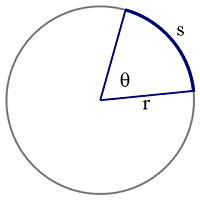- Choose the corresponding Greek letter name from the answer
list in the right hand column:
- _____
θ
- _____
β
- _____
γ
- _____
α
- _____
π
- _____
φ
|
|
- gamma
- beta
- theta
- pi
- phi
- alpha
|
- Choose the corresponding degree measure from
the answer list in the right hand column. Note that some
answers may be used more than once while some may not be used...
- _____ Right angle measure
- _____ Sum of 2 supplementary angle
measures
- _____ Sum of the 3 interior angle measures
for a triangle
- _____ Angle measure of one revolution
- _____ Sum of 2 complementary angle
measures
- _____ Straight angle measure
- _____ Measure of any one interior angle
for an equilateral triangle
- _____ Sum of the 4 interior angle measures
for a rectangle
|
|
- 0
°
- 30
°
- 45
°
- 60
°
- 90
°
- 120
°
- 180
°
- 360
°
|
- Choose the most appropriate answer:
- Vertical angles are ____________ equal.
- seldom
- always
|
- never
- usually
|
- If α and β represent a pair of
complementary angles, then the measure of α must be
greater than _____ degrees but less than
_____ degrees.
- 0, 45
- 0, 90
|
- 0, 135
- 0, 180
|
- If α and β represent a pair of
supplementary angles, then the measure of β must be
greater than _____ degrees but less than
_____ degrees.
- 0, 45
- 0, 90
|
- 0, 135
- 0, 180
|
- Choose the most appropriate answer:
- One degree (1°)
is equal to _______minute(s).
- One minute (1' )
is equal to _______second(s).
- One degree (1°)
is equal to _______second(s).
- Convert each of the following decimal degree
measures to DMS measure (i.e., _____°
_____' _____").
| a. 36.25° |
c. 120.375° |
| b. 48.8° |
d. 15.18° |
- Convert each of the following DMS measures
to decimal degree measure. When appropriate,
round to the nearest thousandth.
| a. 23° 30' |
d. 89° 0' 36" |
| b. 290° 36' |
e. 45° 45' 45" |
| c. 21° 21' |
f. 0° 18' 18" |
- Convert each of the following decimal degree
measures to radians. When appropriate, round to
the nearest hundredth.
| a. 30° |
c. 0.5° |
| b. 11.25° |
d. 57.3° |
- Convert each of the following radian
measures to decimal degrees. When appropriate,
round to the nearest tenth.
| a. π /4 |
c. 1 |
| b. π /2 |
d. 1.3 |
- Convert each of the following radian
measures to DMS.
| a. π /16 |
c. 1 |
| b. 3π /32 |
d. 0.5 |
- Convert each of the following DMS measures
to radians.
| a. 66° 30' |
b. 19° 42' 30" |

Refer to the illustration (shown at
right) for Exercises 11-13 (below)...
- Determine the arc length (s) along the edge of a circle with
radius r and which is subtended by a central angle angle θ:
- r = 10 cm and
θ = 1
- r = 1 7/8 ft
and θ = 45°
- r = 3960 mi and
θ = 1'
- Determine the length of a circle's radius (r) where an arc
length s along the edge is subtended by a central angle θ:
- s = 2 in and
θ = π/6
- s = 1.609 km and
θ = 30°
- s = 3 3/16 yd
and θ = 20°15'
- Determine the measure of the central angle (θ) subtending an
arc length s along the edge of a circle with radius r:
- s = 25.4 mm and
r = 6.35 mm
(answer in radians)
- s = 2 ft and
r = 6 in
(answer in decimal
degrees)
- s = 1/20 m
and r = 10 cm
(answer in DMS)
- Identify the name for each of the following polygons:

- ____________

- ____________

- ____________

- ____________

- ____________
- Choose the most appropriate answer:
- Every "n-sided" polygon has __________ interior angles.
- In any "regular" polygon __________ of the interior
angles are congruent (i.e., equal in measure).
- none
- two
|
- all
- none of the above
|
- Which of the following polygons is NOT a quadrilateral?
- trapezoid
- square
|
- pentagon
- rectangle
|
|